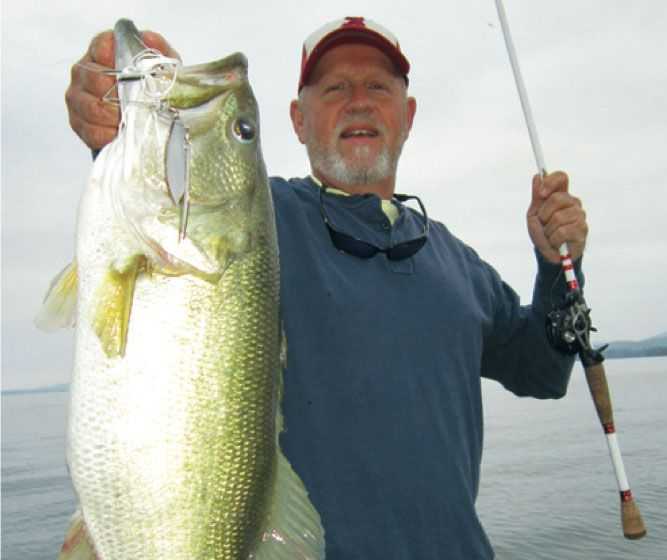
The shad spawn can mean the best bass fishing of the spring if you hit the right spots at the right times. Although it’s a short period of time, shad spawn when the water temperatures hit upper sixties to low seventies and during the full moon. In the Southeast TN, GA and AL this usually means the full moon in April and May. Shad normally spawn right at daybreak. Once the sun gets on the water the shad spawn is usually over for the day; likewise if it remains cloudy it will last longer into the day.
For the most part in the southeast region, the first major wave of spawning bass have either finished or are close to finishing. For a lot of anglers this can signal the beginning of the post spawn blues, however for some anglers it is game time! Shortly after spawning the larger female bass start a migration to deeper water areas to start the recovery process. After a couple of days rest they are hungry. A favorite meal of bass is threadfin shad, especially when they are beginning the spawning ritual.
Threadfin shad can be found in most lakes across the southeast and are the staple diet of all bass from Largemouth in Lake Guntersville and Kentucky Lake to Smallmouth bass in clear, deep lakes such as Tim’s Ford and Lanier. This high protein food source makes them the perfect forage for hungry bass. Threadfin shad generally grow to a size of four to six inches and inhabit a wide range of water depths and temperatures.
Typically the shad are triggered to start their spawn when the water temperature ranges between 68-76 degrees. The shad will spawn in various habitats, depending upon the type of lake. These areas may consist but are not limited to shoreline grass or lily pads, rip rap, wood cover and even boat docks typically in shallow water (three to five feet) with deeper water close by. On lakes such as Lake Guntersville shad can also be found spawning on the main lake grass ledges around deeper water.
Watch for dark clouds of shad traveling the grass lines or rippling of the water right where the water meets the edge of the hard surfaces, such as wood or rocky banks. The school of shad runs down the bank or channel grass and the females lay eggs that stick to the grass and other hard surfaces. The males are running with them and releasing sperm that fertilizes the eggs. I’ve noticed shad jumping completely out of the water onto the bank when they spawn on lakes like Tim’s Ford.
One of the best ways to catch bass during the shad spawn is using a spinnerbait such as a 3/8 to 3/4 ounce Assassinator “Clacker” Spinnerbaits. It has a unique stacked blade configuration, in which the blades actually bang together and garners one of the most violent strikes I’ve experienced. The next best choice is the light wire Punisher Spinnerbait. Silver willowleaf #4 or #5 blades with a white skirt imitate the shad. Another great way to catch bass during this time is top water baits like Assassinator Buzzbaits. It has a head/hook that is set below the water thanks to its 45 degree bend just in front of the head. In addition, a Rapala X-Rap Poppers and walking baits such as Sammy’s are great options. A buzz bait worked slowly will often excite the bass who lurk in shallow cover. If you are fishing close to deep water try Rapala X-Rap Popper. This hard bait will entice from greater depths simply because you can work it slower. I tend to use a top water lure when fishing just prior to the crack of dawn and again as the spinnerbait bite slows after sun up.
Get your boat close and parallel the bank. Try to position your boat behind the shad and keep your movement to a minimum, so not to spook them. See which way they are moving and cast with or across the flow of traffic. Cast your spinnerbait right on the rocks or against the sea wall in areas void of grass. When fishing around grass, allow the spinner bait to “Tick” the grass, then jerk it free and hold on. Here is a tip when fishing grass ledges. As your lures clears the grass drop to rod tip, stop your retrieve for a few seconds, then pop the tip once or twice. Many times bass will congregate near the edge of the grass waiting for unsuspecting prey. If you suspect this, use a stick bait similar to a wacky rigged Yamamoto Senko, you won’t be disappointed with the results. You can’t cast too shallow! Some bass will be amazingly shallow, looking for shad almost out of the water. Start your retrieve as soon as your bait hits the water and be ready to set the hook immediately. Bass will often hit as soon as the bait hits the water when using either a top water lure or spinnerbait.
My preferred equipment set up when using a spinnerbait or popper is a 6’9” to 7’0” Medium Heavy Duckett Micro or Ghost Rod, LEW’s 6.4:1 reel spooled with 15-17 pound test Vicious Ultimate Co-Poly line. With this set up your rod has just the right tip action to properly work the lure and still enough backbone to keep the beast hooked up. With Buzzbaits, I’ll arm my clients with a 7’0” Heavy Duckett Micro or Ghost Rod. LEW’s 6.4:1 or 7:1 reel spooled with 50 pound test Vicious Braid because we are normally throwing it in or around heavy cover and your going to need to extra power to drag them out!